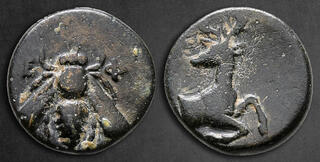| Savoca Numismatik GmbH & Co. KG > Online Auction 209 | Silver | Auction date: 28 April 2024 |
| Lot number: 117 Price realized: Unsold | Show similar lots on CoinArchives Find similar lots in upcoming auctions on |
| Lot description: Ionia. Ephesos circa 387-285 BC. Bronze Æ 10 mm, 1,45 g E-Φ, bee / Forepart of stag right. Very Fine SNG Copenhagen 244. Ephesus, a distinguished ancient Greek city on the western coast of Turkey, bore emblems like the bee, stag, and palm, all of which held profound significance. Central to these symbols was Ephesus' role as a crucial center for the worship of the Greek goddess Artemis, a connection prominently highlighted on its coinage. The bee, stag, and palm were emblematic of Ephesus. Originally, the bee was associated with an early Anatolian goddess, later identified by the Greeks as Artemis. The symbolic connection was so intimate that the priestesses of this goddess were referred to as "honey bees." The palm tree, featured on Ephesian coins, harks back to the myth of Artemis' birth beneath a palm tree on the island of Delos. This imagery evokes the goddess's divine origins and reinforces her connection to nature. The stag, another prominent motif, held dual significance. Sacred to Artemis, it symbolized her role as the protector of wild animals. Additionally, it might allude to the sculptures flanking her cult statue in the temple at Ephesus, further emphasizing the city's devotion to the goddess and the intricate details of her worship. These images on Ephesian coinage served as a visual narrative of the city's profound ties to Artemis, encapsulating not only religious devotion but also the rich mythological tapestry that defined Ephesus as a prominent cultural and religious center in the ancient Greek world. Starting price: 50 EUR |  |


